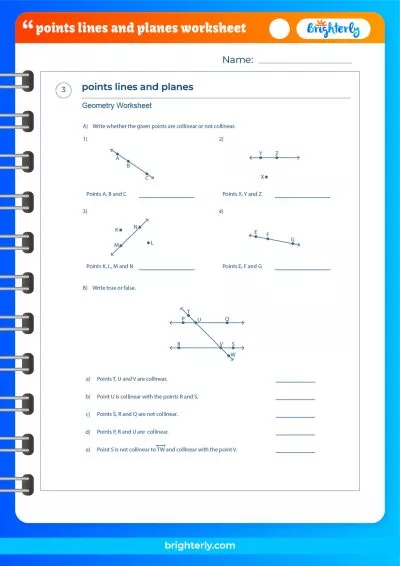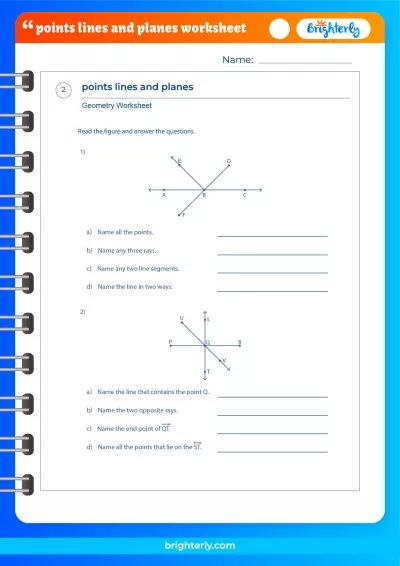Types of Lines – Definition With Examples
Updated on January 15, 2024
Welcome to Brighterly, the premier platform that makes the vast world of mathematics approachable, engaging, and fun for young learners. In our journey through the mathematical universe, we’ve discovered numbers, shapes, angles, and today we’ll be voyaging through the exciting realm of lines!
Lines are everywhere, defining our world in visible and invisible ways. They’re in the pages of your books, in the design of your house, in the streets you walk, and even in the rays of sunlight that reach you. As fundamental elements of geometry, lines help us to understand shapes, spaces, and the very fabric of the universe. So, let’s illuminate the different types of lines and explore their wonders together!
What is a Line?
Before we dive into the various types of lines, let’s define what a line is. A line, in mathematical terms, is an infinite set of points extending in two opposite directions. It is a straight path that has no endpoints, unlike a line segment or a ray. Think of it like a road that goes on forever, both ways. No matter how far you go in either direction, the line doesn’t stop. Lines are fundamental elements in geometry and the basis for understanding shapes and space.
Difference between Line and Line Segment
At first glance, a line and a line segment might look similar, but they have a distinct difference. As we mentioned earlier, a line extends infinitely in both directions. On the other hand, a line segment has two endpoints. This means a line segment starts and ends at a specific point, unlike a line that goes on forever. Picture a section of a ruler; that’s a perfect example of a line segment.
Difference between Line and Ray
What about a ray, you ask? A ray is like a hybrid of a line and a line segment. A ray starts at a specific point (like a line segment) and extends infinitely in one direction (like a line). Imagine a sunbeam shooting out from the sun. That’s a ray! It begins at the sun and travels endlessly in one direction.
What are the Types of Lines in Geometry?
In geometry, we identify various types of lines based on their position or relationship to each other. These include curved lines, straight lines, horizontal and vertical lines, parallel lines, intersecting lines, perpendicular lines, and transversal lines.
If you want to improve your child’s understanding of types of lines, we recommend that you check out Brighterly worksheets. They can significantly improve your child’s math skills.
a) Curved Lines:
A curved line, as the name suggests, is not straight but bends at one or many points. They’re common in our daily lives, from the design of a soda can to the structure of a rainbow. Curved lines add an artistic flair and are used extensively in graphic designs and art.
b) Straight Lines:
Straight lines, on the other hand, do not bend. They are the shortest distance between two points. Highways, edges of books, and lines on a sheet of paper are examples of straight lines. Straight lines can run horizontally, vertically, or slant at an angle.
c) Horizontal Lines:
Horizontal lines are straight lines that run from left to right, parallel to the horizon. These lines do not slope. If you’re standing on a flat field and looking at the horizon, you’re looking at a horizontal line!
d) Vertical Lines:
Vertical lines, in contrast, are straight lines that run up and down. Imagine a tall skyscraper or a flagpole – these are examples of vertical lines.
e) Parallel Lines:
Parallel lines are straight lines that run alongside each other without ever intersecting. Think of the two sides of a ladder or a railway track, they’re perfect examples of parallel lines.
f) Intersecting Lines:
Intersecting lines are lines that cross at a point. The point where they cross is called the intersection. If you’ve ever seen a ‘+’ sign, then you’ve seen intersecting lines.
g) Perpendicular Lines:
Perpendicular lines are a special type of intersecting lines. They intersect at a right angle (90 degrees). The corners of a square or a rectangle are examples of perpendicular lines.
h) Transversal Lines:
A transversal line is a line that crosses at least two other lines. These other lines could be parallel, intersecting, or neither. When a road cuts across two or more streets, that’s an example of a transversal line.
Practice Problems on Types of Lines
Now that we’ve learned all about the different types of lines, let’s put that knowledge into practice. Here are some interactive problems to test and strengthen your understanding.
-
Identify the Type of Line: Look at the picture below. The blue line is running parallel to the ground. What type of line is it?
-
Spot the Perpendicular Lines: In the following image, can you spot the lines that are perpendicular to each other?
-
Name that Line: Observe the image below. The line goes on indefinitely in only one direction. What’s the name of this type of line?
-
Intersecting or Parallel?: Consider the following picture. Are the lines intersecting or parallel?
-
Line Segment or Line?: In the given image, the line has two endpoints. Is it a line segment or a line?
Take your time with these problems. Remember, learning is a journey, not a destination! For answers and more exercises, visit our answer key and practice problems page.
Conclusion
As we reach the end of our thrilling journey through the diverse world of lines, we hope you’ve enjoyed and learned from this exploration. At Brighterly, we believe that every concept, every lesson brings us one step closer to understanding the world around us and, in the process, understanding ourselves a little better. Lines, in their various forms, play an incredible role in shaping that world and our experiences in it.
Remember, understanding lines isn’t just about knowing the difference between a line and a ray or recognizing a perpendicular line. It’s about observing, questioning, and interacting with the world around you. Because when you start to see the lines that draw the world, you begin to see the beauty and symmetry of the universe. Keep exploring, keep learning, and remember, Brighterly is here to light your way!
Frequently Asked Questions on Types of Lines
You’ve explored the various types of lines, practiced with examples, but you might still have some questions. Let’s address some of the common questions young learners like you often have.
Why is it important to learn about lines in geometry?
Learning about lines in geometry is fundamental because they are the simplest form of geometric figure, and they form the basis for understanding more complex shapes. They help us describe the world around us – roads, buildings, letters, drawings; everything involves the use of lines.
What is the difference between a line and a line segment?
A line is infinite; it extends endlessly in both directions. A line segment, on the other hand, is part of a line that has two specific endpoints. Think of a line as a road that goes on forever, while a line segment is a piece of that road between two specific towns.
Are all straight lines also horizontal lines?
Not all straight lines are horizontal. A straight line can be horizontal, vertical, or slanted. A horizontal line is a straight line that runs from left to right, parallel to the horizon. So while all horizontal lines are straight, not all straight lines are horizontal.
Can curved lines be parallel too?
Yes, curved lines can be parallel too. Parallel lines are lines in a plane that never meet, regardless of how far they extend. While we often think of parallel lines as straight, two curves that keep an equal distance apart are considered parallel as well.






